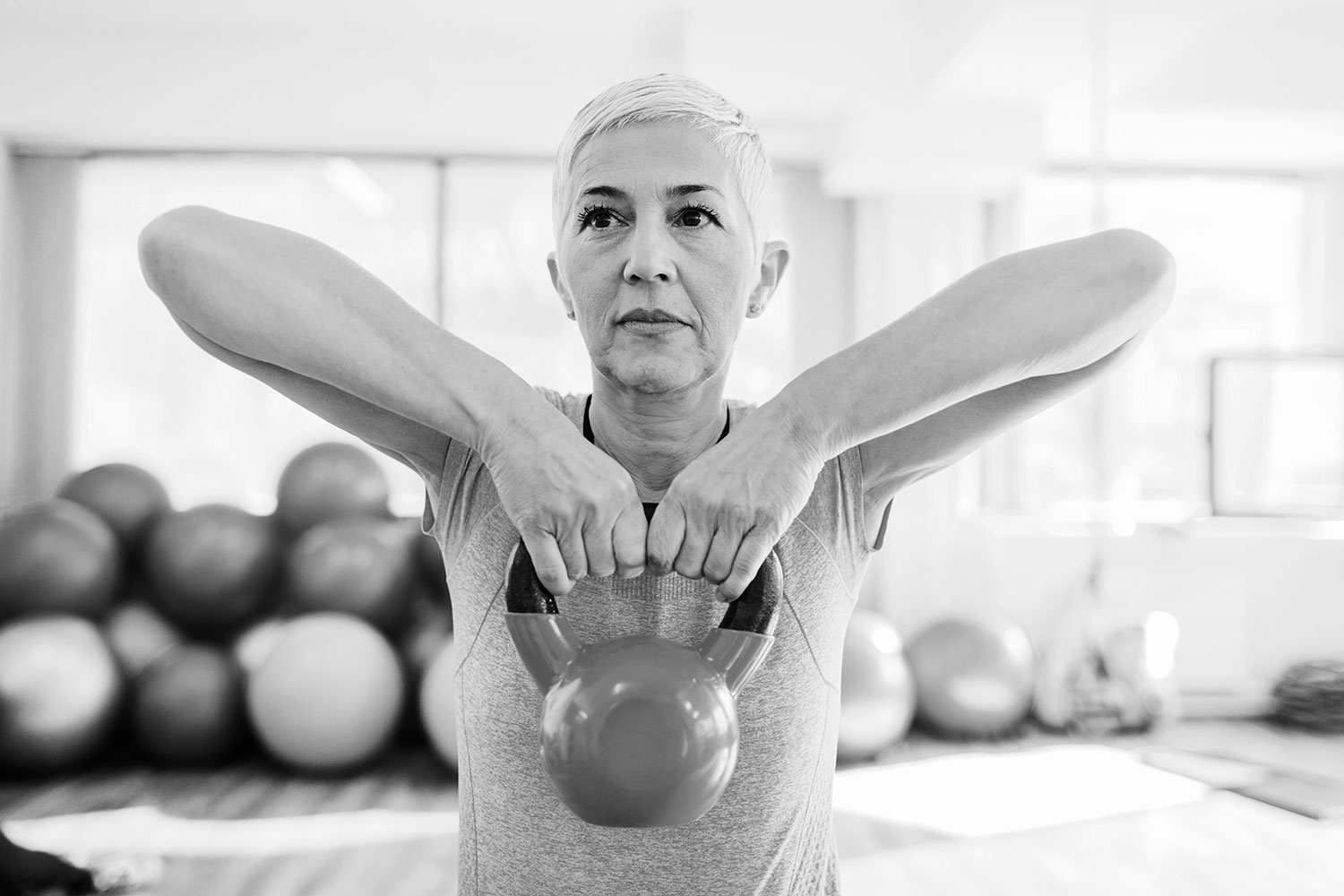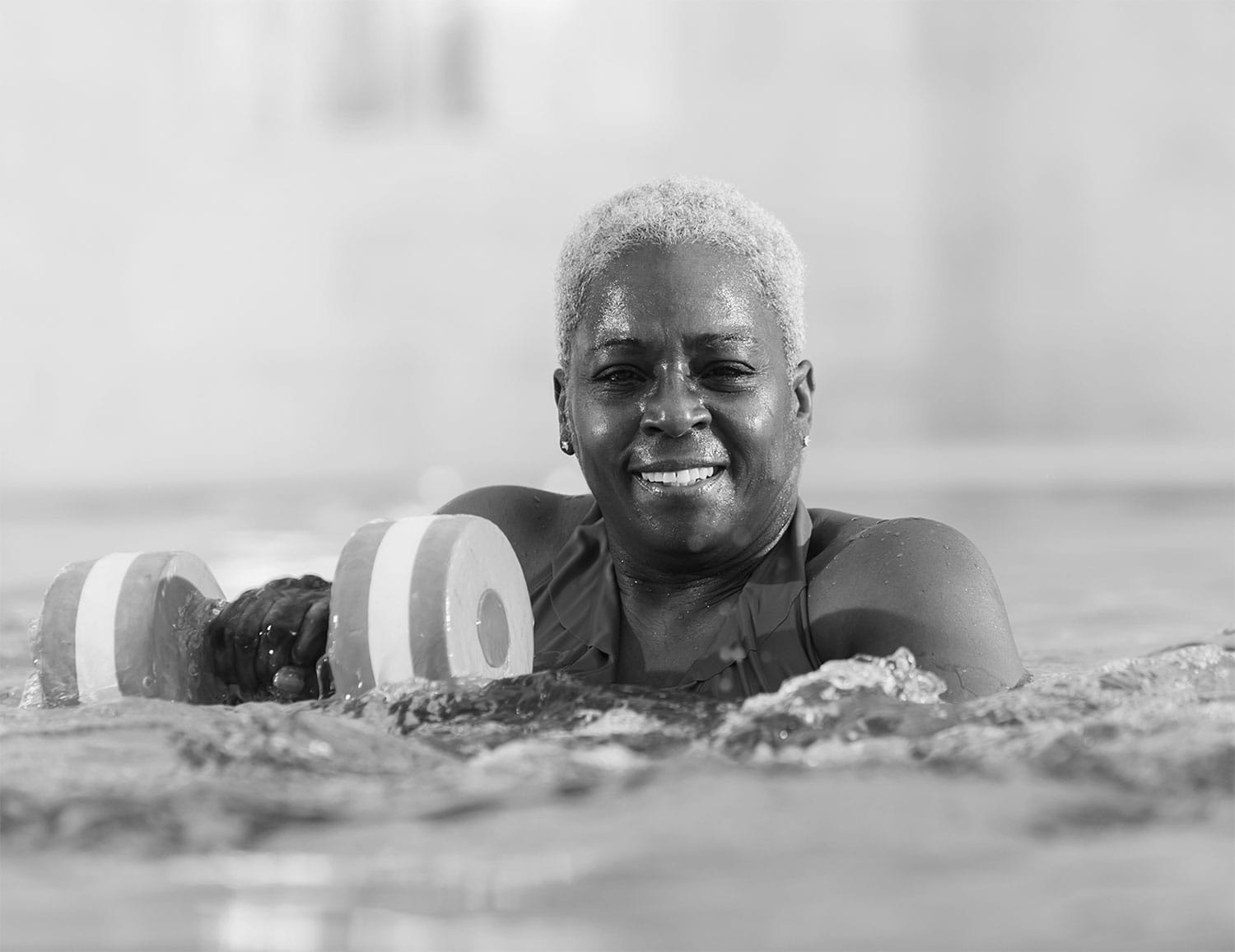IN JULY 2010, 52-year-old Julie Barthels, a clinical director of a rape crisis center, woke up with a sharp pain in her right breast. When the pain persisted for more than a week, Barthels, who lives in Machesney Park, Illinois, had a mammogram that revealed a mass in her breast of more than 2 centimeters. After a lumpectomy, Barthels was diagnosed with stage IIA breast cancer.
At the end of September, Barthels had additional surgery to remove her right breast and surrounding chest muscles and lymph nodes. She started chemotherapy a month later, and soon afterward noticed swelling on her right side and in her upper arm. Eventually, she couldn’t stretch her arm over her head. Barthels had developed a condition called lymphedema, swelling that occurs when lymph fluid builds up in the body’s tissues, typically in the legs or arms. Lymphedema is a common complication following surgery to remove lymph nodes.
Barthels’ primary care physician referred her for occupational therapy. Barthels, who had recently undergone rehabilitation for injuries sustained in a motorcycle accident, was no stranger to this type of therapy. In January 2011, she started meeting with an occupational therapist two to three times a week. The therapist used a special type of massage to decrease lymphedema swelling by moving lymph toward areas of the body where it can drain more easily. Over the course of four months, the therapist taught Barthels how to perform self-massage and advised her to use a compression shirt to manage her condition.
Barthels, now 61, says the exercises and techniques she learned helped her maintain her mobility even as she continued weekly chemotherapy treatments. “I have so much movement and flexibility that I would not have if I hadn’t learned to take care of myself,” she says.
A Missing Piece
Occupational and physical therapy are components of care that fall under the wide umbrella of cancer rehabilitation, a field that aims to help cancer survivors improve their ability to function, return to daily activities and pastimes, and boost quality of life. Besides physical function, cancer rehabilitation can also focus on nutritional counseling and psychological counseling to help people manage pain, fatigue, depression and other challenges resulting from cancer and treatment.

Photo © iStock / vgajic
Still, doctors may not always prescribe outpatient rehabilitation for cancer patients—even though many patients report having functional limitations that affect their daily lives. In a study published in 2015 in the Journal of Geriatric Oncology, for example, 341 of 529 cancer survivors from ages 65 to 97 who were enrolled in a cancer registry reported at least one functional limitation to their doctors. Researchers randomly reviewed charts for 65 of these patients, and found that only 11 charts made mention of physical or occupational therapy.
“Rehabilitation has not been part of what we would call traditional cancer care,” says Nicole L. Stout, a physical therapist based in Sarasota, Florida, who is a project coordinator for the National Institutes of Health’s Cancer Rehabilitation Initiative, which supports national and international efforts to improve cancer rehabilitation. “It’s critical that we find ways to better integrate rehabilitation services into the cancer care continuum, because patients do better with these interventions.”
Some studies support this assertion. A 2010 study in the BMJ looked at 120 women with breast cancer whose surgery removed some of their lymph nodes. The researchers found that women who received education and physical therapy that included stretching, shoulder exercises and specialized massage therapy to circulate lymphatic fluid were less likely to have lymphedema than those who received only educational materials.
In addition, a review published in Rehabilitation Oncology in July 2018 found that a variety of lower limb exercises designed to strengthen and coordinate movement helped improve cancer survivors’ balance and reduce pain and tingling associated with neuropathy. The review also suggested that strength training had positive effects on balance, strength and quality of life.
When Barthels started having trouble walking due to pain and weight gain in the spring of 2011, her primary care physician gave her a referral for physical therapy, where she learned exercises to build balance and to strengthen her core muscles by working out on a balance ball. Her therapist also incorporated weekly aquatic therapy, using special weights designed for use in the pool, which helped Barthels strengthen her hips and improve her gait. “Just being in the warm water helped me to loosen and build muscles that had become stiff from so much time resting,” Barthels says.
Can assessing and preconditioning cancer patients prior to treatment help them make greater strides?
A 2017 analysis reported in the Cochrane Database of Systematic Reviews included five studies of people with non-small cell lung cancer who were undergoing lung resection. Four of the included studies suggested that patients who underwent a short exercise program before surgery lowered their risk of lung complications after surgery. They also shortened their hospital stays by an average of four days compared to patients who had no exercise training. Average hospital stays for patients who did not participate in exercise training before surgery ranged from nine to 12 days.
In addition, a study presented at the May 2018 ERAS World Congress in Stockholm, Sweden, found that 17 of 20 people with colorectal cancer who participated in a prehabilitation program that included high-intensity training, high-protein diets, smoking cessation and psychological counseling before surgery returned to their baseline fitness four weeks after surgery. Of the 30 people who did not participate in the prehabilitation program, just 12 returned to their baseline fitness in the same time frame.
Although randomized controlled trials are needed to gauge the effectiveness of prehabilitation for various cancer types, another study has called attention to the cost-effectiveness of using this approach. A 2012 study published in Physical Therapy modeled the costs of two approaches to treating lymphedema in women diagnosed with breast cancer, and found that when women received preoperative assessments of function and were monitored regularly by a physical therapist, lymphedema could be found and treated earlier at a reduced cost. Researchers concluded that the proactive treatment model would cost about $636 annually, while the traditional model for treating lymphedema—referring a woman for rehabilitation only when she experienced symptoms after cancer treatment—would cost about $3,124 a year.
“I really believe very strongly that rehab should not be an afterthought,” says Nicole L. Stout, a physical therapist and project coordinator for the National Institutes of Health’s Cancer Rehabilitation Initiative, who led the study. “We shouldn’t wait for individuals to have problems. Early intervention makes such a difference.”
Fluctuations in Function
Developing effective cancer rehabilitation programs can be challenging because each person may have different needs, says Rajesh Yadav, a rehabilitation physician at the University of Texas MD Anderson Cancer Center in Houston. Unlike patients recovering from an injury that can follow a linear path from illness to wellness, a cancer patient’s health may fluctuate over time. “You have to have a handle on what’s going on with the cancer now,” Yadav says.
A rehabilitation physician like Yadav looks at the big picture of the person’s health, assessing physical function in addition to needs at work and home. “This patient is not just a tumor in one body part,” Yadav says. “We’re looking at a holistic view.”
Whether patients are learning how to deal with fatigue, getting familiar with using a walker or relearning how to drive, the goal is to help them do what they value, says Mackenzi Pergolotti, an occupational therapist and the director of research at ReVital Cancer Rehabilitation. Pergolotti presented research in November 2017 at the International Society of Geriatric Oncology meeting in Warsaw, Poland, that showed that adults over 65 who received physical therapy to bolster strength and endurance, coupled with occupational therapy to address daily function, had better scores on mental health assessments compared to those who received standard care. In addition, Pergolotti says, people who participated in the rehabilitation program in her study were more likely to say that they believed they could participate in the activities they value. “We think that may signify [that] older adults with cancer are more likely able to participate in what they find meaningful after rehabilitation,” she says.

Photo © iStock / Tinpixels
Gwen Stevens of Magnolia, Texas, was diagnosed with stage IV ovarian cancer in June 2015. After a nearly eight-hour operation to remove tumors, reproductive organs, and part of her intestine, she received the chemotherapy drugs carboplatin and Taxol (paclitaxel) every three weeks over five months. After treatment, she had no evidence of disease, but in September 2016, a CT scan revealed a tumor in her upper abdomen. She had surgery to remove the tumor and started another six rounds of chemotherapy early in 2017.
After completing her treatments, Stevens, who had previously walked four miles a day, could barely take a single step. She also developed severe neuropathy in her hands and feet, and frequently found herself forgetting words and having trouble concentrating.
In an online search, Stevens, a paralegal, found TIRR Memorial Hermann-The Woodlands, a specialized rehabilitation hospital not far from her home that offers inpatient and outpatient cancer rehabilitation services. She asked for a referral from her doctor, and in April 2017, she started physical and occupational therapy to improve balance and increase strength. She also visited a speech therapist twice a week for several months to learn techniques to help her improve her reading and memory skills.
“The therapy was a blessing,” says Stevens, who began to drive again, something she hadn’t done in months, and was able to return to work in September 2017. Since then, a CT scan has revealed another tumor on her spleen, and the challenges of her new treatment regimen have caused her to once again stop working. Still, Stevens keeps up with her occupational therapy exercises and continues to walk as much as she can to maintain her strength for chemotherapy treatments. “I wouldn’t be where I am right now without it,” she says of her therapy.
Barriers to Access
Several factors can contribute to patients not accessing rehabilitation services, however. Many health care providers tell cancer patients that treatments can be taxing. “In some ways, that’s helpful, because it helps them adjust their expectations,” says Kathleen Lyons, a rehabilitation scientist at Dartmouth-Hitchcock Norris Cotton Cancer Center in Lebanon, New Hampshire. But patients often feel overwhelmed by their illness, she says, and may not think to ask for rehabilitation therapies. “The onus is on us to make sure patients know there are options to treat their symptoms,” Lyons says.
Pergolotti’s experience suggests that older patients who live near a rehabilitation center are more likely to participate in a program than those who live farther away. And even though inpatient and outpatient rehabilitation services are covered under Medicare, cost can be a barrier to accessing these treatments. A patient’s out-of-pocket costs will vary depending on their supplemental insurance. “It’s hard to nail down the exact cost because there are so many different types of supplementary insurance added to Medicare,” Pergolotti says.
Despite these challenges, cancer rehabilitation recommendations have made their way into professional guidelines. In 2009, the National Comprehensive Cancer Network recommended physical or occupational therapy for cancer survivors who have lost function because of neuropathy. The American Society of Clinical Oncology has integrated rehabilitation into its treatment guidelines for head and neck cancers and breast cancer, as well as into guidelines for managing chronic pain. In April 2017, the American Occupational Therapy Association published professional guidelines for managing the needs of cancer patients and survivors.
Barthels, the breast cancer survivor in Illinois, says she still uses what she learned during rehabilitation. Between 2014 and 2016, she was diagnosed with several basal cell and pre-squamous cell carcinomas on her face, back and arm. Then, in 2016, she was diagnosed with stage I kidney cancer and had surgery to remove part of her right kidney. Barthels, who was training for a triathlon before her initial cancer diagnosis in 2010, still tries to exercise every day. Her regimen includes going for walks and swimming in the pool. “I will not say that I am the athlete I was before cancer,” she says. “But what I can do now was greatly enhanced by my physical and occupational therapy experiences.”
Cancer Today magazine is free to cancer patients, survivors and caregivers who live in the U.S. Subscribe here to receive four issues per year.





